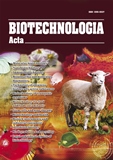ISSN 2410-7751 (Print)
ISSN 2410-776X (Online)

P. 42-43, Bibliography 5, Engl.
UDC: 577.218+616-006
DOI: https://doi.org/10.15407/biotech16.02.042
Full text: (PDF, in English)
Palladin Institute of Biochemistry of NAS of Ukraine, Kyiv
The aim of the present study was to find out the role of Ruk/CIN85 in modulation of activities/content of key enzymes/components of glycolysis and hydrogen peroxide using as a model human NSCLC MOR wild type and resistant to drugs MOR/0.2R cells.
The activities of lysyl oxidase (LOX) and diamine oxidase (DAO) were significantly higher in resistant cells It has been shown that these enzymes are associated with aggressiveness of tumor cells. Based on the obtained results, we draw a conclusion that observed changes in the intensity of glycolysis, amine oxidases activities and content of hydrogen peroxide in doxorubicin-resistant MOR/0.2R cells positively correlate with the expression level of the adaptor protein studied.
References
...1. Hanahan D., Weinberg R. A., Hallmarks of cancer: the next generation. Cell, 2011, 144(5), 646–674.
https://doi.org/10.1016/j.cell.2011.02.013
2. Samoylenko A., Vynnytska-Myronovska B., Byts N., Kozlova N., Basaraba O., Pasichnyk G., Palyvoda K.,
Bobak Y., Barska M., Mayevska O., et al. Increased levels of the HER1 adaptor protein Rukl/CIN85
contribute to breast cancer malignancy. Carcinogenesis, 2012, v. 33, p. 1976–1984. https://doi.
org/10.1093/carcin/bgs228
3. Horak I. R., Gerashchenko, D. S., Drobot L. B. Adaptor protein Ruk/CIN85 modulates resistance to
doxorubicin of murine 4T1 breast cancer cells. The Ukr. Biochem. J., 2018; 90(3), p. 94–100. https://
doi.org/10.15407/ubj90.03.094
4. Liburkin-Dan T., Toledano S., Neufeld G. Lysyl Oxidase Family Enzymes and Their Role in Tumor
Progression. Int. J. Mol. Sci. 2022, 23(6249). 1–14. https://doi.org/10.3390/ijms23116249
5. Xu F., Xu Y., Xiong J-H., Zhang J-H., Wu J., Luo J., Xiong J-P. AOC1 Contributes to Tumor Progression
by Promoting the AKT and EMT Pathways in Gastric Cancer. Cancer Management and Research. 2020,
v. 12, p. 1789–1798. https://doi.org/10.2147/CMAR.S225229
Figure.

